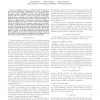Free Online Productivity Tools
i2Speak
i2Symbol
i2OCR
iTex2Img
iWeb2Print
iWeb2Shot
i2Type
iPdf2Split
iPdf2Merge
i2Bopomofo
i2Arabic
i2Style
i2Image
i2PDF
iLatex2Rtf
Sci2ools
ICCAD
2005
IEEE
2005
IEEE
Kauffman networks: analysis and applications
Abstract— A Kauffman network is an abstract model of gene regulatory networks. Each gene is represented by a vertex. An edge from one vertex to another implies that the former gene regulates the latter. Statistical features of Kauffman networks match the characteristics of living cells. The number of cycles in the network’s state space, called attractors, corresponds to the number of different cell types. The attractor’s length corresponds to the cell cycle time. The sensitivity of attractors to different kinds of disturbances, modeled by changing a network connection, the state of a vertex, or the associated function, reflects the stability of the cell to damage, mutations and virus attacks. In order to evaluate attractors, their number and lengths have to be computed. This problem is the major open problem related to Kauffman networks. Available algorithms can only handle networks with less than a hundred vertices. The number of genes in a cell is often larger. In this paper, ...
| Added | 16 Mar 2010 |
| Updated | 16 Mar 2010 |
| Type | Conference |
| Year | 2005 |
| Where | ICCAD |
| Authors | Elena Dubrova, Maxim Teslenko, Andrés Martinelli |
Comments (0)

